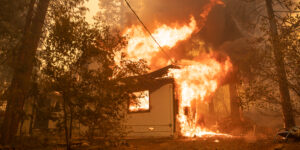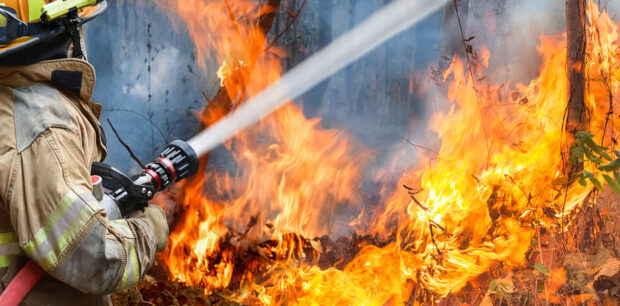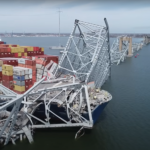Pacific Gas & Electric—one of the nation’s largest utilities whose equipment has sparked some of California’s deadliest wildfires—wants to bury power lines in some of its most at-risk areas to prevent destructive blazes like the 2018 Paradise fire that killed 85 people.
But state regulators are balking at the utility’s plan because it would take too long and cost $5.9 billion. The company’s customers— who already have some of the highest rates in the country—would have to pay for it.
Regulators want PG&E to put a protective cover over many of its overhead power lines instead of burying them. The cover approach is cheaper, but riskier. PG&E says burying a power line reduces the chance it will start a wildfire by 99 percent because it can’t be blown down by wind storms. The protective cover, which would better insulate the power line should it fall to the ground, would reduce that chance by 62 percent.
“We’re not going to live with 35 percent risk,” said PG&E CEO Patti Poppe, who was rounding down in her assessment. “Who wants to get on a plane that has a 35 percent chance of crashing?”
PG&E, which filed for bankruptcy protection in 2019 after it faced more than $30 billion in damages for wildfires started by its equipment, is trying to convince regulators that its burying plan is better. The company filed its plan with state regulators last year.
The California Public Utilities Commission, whose members are appointed by Gov. Gavin Newsom, is scheduled to decide the issue next month. PG&E will make it’s case in person before the commission on Wednesday.
What PG&E wants to do is unprecedented in both scale and speed. It’s plan to bury 2,000 miles (3,219 kilometers) of power lines is part of a broader goal of putting 10,000 miles (16,093 kilometers) underground over the next decade. The case is being closely watched, not just in California but throughout the country as more utilities weigh the risks versus the cost of burying power lines.
Most of the nation’s power lines are above ground because its cheaper to do it that way. But more utilities have been burying power lines in response to bigger and more destructive natural disasters. In Florida, where hurricanes are more of a threat than wildfires, about 45 percent of Florida Power and Light’s distribution system is underground, according to the company`s website.
California’s other big investor-owned utilities have also been putting power lines underground. Southern California Edison, the utility that covers much of central and Southern California, says it plans to bury 600 miles (966 kilometers) of power lines by 2028. San Diego Gas & Electric has buried 145 miles (233 kilometers) of power lines since 2020 and plans to do another 1,500 miles (2,414 kilometers) by 2031.
The issue can have repercussions beyond the price of electricity. In the past year, seven of the top 12 insurance companies doing business in California have either paused or restricted new business in the state, citing wildfire risk.
On a recent afternoon, Poppe—PG&E’s CEO since 2021— visited a construction site between Sacramento and San Francisco where crews were burying a stretch of overhead power lines. Poppe was there to celebrate the company meeting its goal of burying at least 350 miles (563 kilometers) of power lines this year, a milestone she says is proof the company can meet its ambitious targets.
Poppe donned a hard hat and protective glasses to watch workers pour a concrete mixture into a freshly dug trench along a rural, two-lane road. Behind them, charred trees stood sentry on brown hills, evidence of the 2020 LNU Complex Fire that destroyed nearly 1,500 structures and killed six people. That fire was started by lightning, not PG&E`s power lines, but it is a reminder of the lasting damage that wildfires can cause.
“One of the big criticisms about PG&E is we did not adapt to changing conditions. Everyone says we should have seen these wildfire conditions. Everyone says PG&E should have invested in the infrastructure,” Poppe told The Associated Press. “And so, here we are. We’ve now changed and we’re asking people to catch up with us.”
Critics scoff, noting that PG&E’s plan would boost profits for a company that pleaded guilty to 84 counts of manslaughter in connection with the 2018 wildfire that mostly destroyed the town of Paradise. Their plan, which includes projects in addition to burying power lines, would raise customer rates an average of nearly 18 percent, or $38.73 per month.
“I really find it hard to believe anything they say about their commitment to safety. They are going to make a lot of money burying these lines,” said Ken Cook, president of Environmental Working Group and a PG&E customer.
The Public Utilities Commission is considering two other plans that would include both burying power lines and using protective coverings. The plans reduce the number of power lines that PG&E could bury by at least half. One plan would raise rates by just over 12 percemt and the other would raise rates by about 10 percent.
Already, PG&E’s residential rates have more than doubled since 2006. It’s been even worse for low-income customers, whose rates have gone up 170 percent over that same time period, according to The Utility Reform Network, an advocacy group for ratepayers. PG&E says its electric-only rates have increased an average of 4 percent per year since 2006.
While burying power lines is the most effective way to prevent wildfires, it is not a quick fix. It takes a long time compared to other methods because of time needed to plan, and acquire the necessary permits and permissions to dig.
At the start of 2018, both PG&E and Southern California Edison had only 5 percent of their high-threat fire districts protected with either underground lines or protective covers, according to the California Public Advocates Office, the state agency that represents customers before the Public Utilities Commission.
Five years later, 55 percent of Southern California Edison’s equipment in high-threat fire districts are protected compared to just 9 percent of PG&E’s system. Matt Baker, director of the California Public Advocates Office, says it’s good for PG&E to bury some power lines – but they must also use other methods to get more areas protected faster.
“We have to get it done as quickly as possible to reduce the risk as much as possible,” Baker said. “It doesn’t matter if we have like this incredibly gold- plated, awesome, underground system if, over the next ten years, we’ve got a hundred or so wildfires that are starting to hit the other places because we’re not there yet.”
PG&E says it had improved protections for 14 percent of its system in areas at high risk for wildfires by the end of 2022. Plus, it says it has more than two and a half times more miles of distribution lines in high-risk areas than Southern California Edison.
Poppe, PG&E’s CEO, says the company has a “a moral obligation” to reduce wildfire risk. Poppe said she still wears a lady bug pin on her shirt every day to remind her of Feyla McLeod, an 8-year-old girl who died in a 2020 Northern California wildfire that was started by PG&E’s equipment.
“Every day I’m recommitting to preventing that from happening again,” she said.





















 USAA to Lay Off 220 Employees
USAA to Lay Off 220 Employees  Munich Re Specialty Launches FAIR Plan Commercial Wrap Product in California
Munich Re Specialty Launches FAIR Plan Commercial Wrap Product in California  Maritime Law Invoked By Ship Owner in Baltimore Bridge Collapse to Cover Salvage Costs
Maritime Law Invoked By Ship Owner in Baltimore Bridge Collapse to Cover Salvage Costs  The Supreme Court Just Complicated Employer Diversity Initiatives
The Supreme Court Just Complicated Employer Diversity Initiatives 



